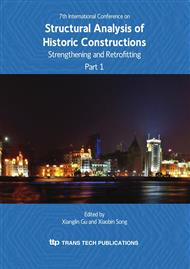p.491
p.497
p.503
p.509
p.515
p.519
p.525
p.531
p.537
Structural Behavior Analysis of Masonry Stone Pagoda Considering the Inner Construction Types of Stylobate
Abstract:
We have many difficulties in the modeling and analysis of masonry stone pagoda structure because this structure has the discontinuum behavior characteristics, compared with the general continuum structures. Also, we need to consider the inner construction types of stylobate for the reasonable analysis of structural mechanism of masonry stone pagoda. Most masonry stone pagoda structures built in Korea are largely classified into three parts such as top part, body part and stylobate. Specifically, the stylobate takes a very important structural part, performing the role of foundation in ordinary structures, and the reduction of stylobate’s bearing capacity has great influence on the safety of structure. As for stylobate, the construction types of inner Jeoksim result in the different structural behaviors. Therefore, this study selects three-story stone pagoda in Goseon-sa temple site that shows the typical type of stone pagoda structure in Korea. Also, this study investigates the construction types of stylobate and evaluates the structural and mechanical behaviors of masonry stone pagoda structure according to many application variables of stylobate’s Jeoksim forms. To this end, we considers the contact surface and block modelling for the discontinuum elements through the discrete element method and finite element method. Through the comparison of analysis results, we can find out the load transfer mechanism according to the inner Jeoksim types of stylobate.
Info:
Periodical:
Pages:
515-518
Citation:
Online since:
October 2010
Price:
Сopyright:
© 2010 Trans Tech Publications Ltd. All Rights Reserved
Share:
Citation:


